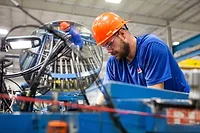Minimizing Human Error in Adhesive Coating Applications


Properly mixing two-component coatings and adhesives can be difficult. The materials, typically supplied in bulk, must be mixed in accordance with precise written instructions. Many users lack the necessary experience mixing different chemicals together, which can lead to inconsistencies and, in turn, poor curing and even product failure. Poor mixing can affect the properties of an adhesive or coating and negatively impact its shelf life and quality. Additionally, poor mixing results are often not discovered until it is too late and expensive to address.
To reduce the risk of human error, new cartridge technology is available from Sulzer Mixpac that provides different ratios for specific industry applications. Static mixers attach to these cartridges to blend the material and create a very consistent mix.
Human error has serious consequences in adhesive coating dispensing technologies
Adhesives are selected for specific end uses associated with a product. For example, the surface of a cellphone or the wing of an aircraft must withstand demanding physical and environmental conditions. Mix quality and on-ratio dispensing is critical for achieving the desired specification and manufacturing of quality products.
Adhesives are specified into an assembly and if a mixture fails to meet specifications, the assembly, itself, could fail. If material is mixed improperly, it may often fail to cure to specified properties. The results can be adhesive or coating material that is too soft or gummy, too brittle, or dispenses with a yellowish appearance rather than clear. Of far greater concern, improperly mixed material can also present a potential safety hazard and, in worst case scenario, manifest catastrophic consequences. One example where this occurred is when a concrete ceiling panel in a major metropolitan tunnel dislodged and killed a driver. The concrete panels of the tunnel were held in-place with adhesive and rebar. However, an investigation into the incident revealed adhesive failure, which was due, in part, to improper missing and a failure to cure.
Causes and Effects of Human Errors
Imagine a large structure or building with huge numbers of people working on the construction. There is the potential for many different people mixing and applying adhesives, with each one’s mix turning out slightly different. Mix time and method can be shorter or longer, clockwise or counterclockwise. All these inconsistences increase the chance of myriad different failures. Therefore, it is critical for adhesive companies to ensure that material is as consistent as possible. It must be “dummy proof,” so anyone who applies the material gets the exact results every time. This increases efficiency, leads to improved quality, and less cost for rework. Less rework ultimately increases the potential for cost savings.
Cartridge-Based Systems Reduce Human Error
Mixing by hand requires proper training. Employees must be properly trained by the coating/adhesive manufacturer on the right way to mix the product to achieve the product specifications. The problem is that training may become diluted the further downstream the distribution level goes. Additionally, individuals purchasing paint or glue from a store may not know how to use it and are often unlikely to receive the proper training.
By contrast, cartridge-based systems greatly reduce the chances for human error. These systems require minimal training and experience regarding pouring, mixing and operation. Rather, simple instructions show users how to quickly install a cartridge and operate the dispenser, greatly reducing the risk of human error while ensuring effective and consistent mixing.
Cartridge-based systems are available for many different ratio products. They work with a variety of static mixers designed for both high and low viscosity products.
One example is Sulzer Mixpac’s Mixpeel™ product, which is a packaging and dispensing solution that fits two components in a one-component style cartridge. The 2-in-1 concept is particularly useful for reducing error in the construction sector and can be used for chemical anchoring, 2-component sealing, and crack repair. It is easy to quickly fill the cartridge from the nose, and the pistons come pre-inserted, which streamlines the process. Mixpeel™ also has a large 280 ml fill volume, providing additional capacity compared to other options. In addition, the retained waste volume is much lower than other products, which provides environmental benefits. The 2-in-1 package design allows the use of a one-component dispenser, which is a huge advantage when choosing a cost efficient and lightweight dispensing method.
Looking for a reprint of this article?
From high-res PDFs to custom plaques, order your copy today!







